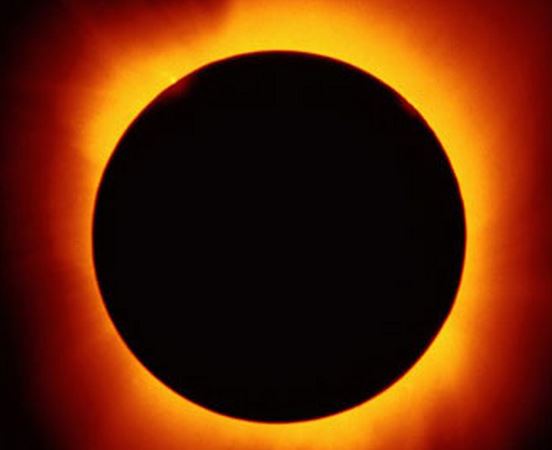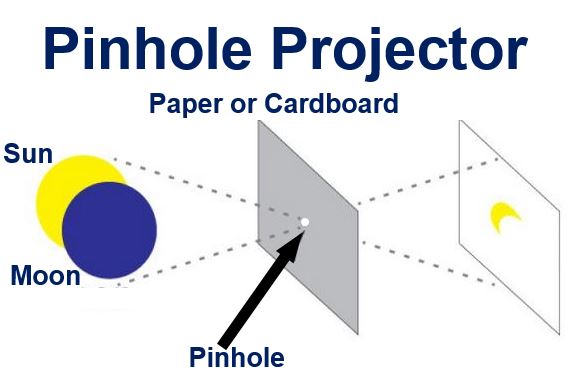On March 20th there will be a solar eclipse and also a Supermoon, which is called a Supermoon Eclipse. A Supermoon is when the Earth and the Moon are as near as they can be to each other. A solar eclipse occurs when the Moon comes in between the Earth and the Sun and blocks the Sun’s light.
The UK will experience a partial solar eclipse – from 98% obscuration (darkness) in the Isle of Lewis in the Outer Hebrides in Scotland, the far north of the country, to 85% at the southern tip.
The Faroe Islands and the Svalbard will have a total eclipse. For a total eclipse to coincide with the Spring Equinox is a rare event, and will occur only three more times this century (2034, 2053 and 2072) and not at all in the 22nd century.

Remember that it is dangerous to look up at the solar eclipse without protection.
Authorities in the Faroe Islands, an archipelago between Norway and Iceland, say all their hotels, hostels and bed and breakfasts are fully booked on the day of the solar eclipse. However, several households have come forward offering themselves as host families, where there are still vacancies.
The Faroe Islands Tourist Board wrote:
“The event will be celebrated by the Faroese and tourists all across the country. After the solar eclipse, the remainder of the day will be packed wth a wide variety of cultural- and musical events, tours, activities and opportunities to try local Faroese foods, among other things.”
Partial obscuration will be experienced by people across the whole of Europe, West and North Africa, and Northern Asia on March 20th.
What happens during a solar eclipse?
Solar eclipses occur when the Moon passes in a direct line between the Sun and the Earth. The Moon’s shadow passes over the Earth’s surface and blocks out the sun’s light.
The Moon orbits our planet at an angle of approximately 5 degrees relative to the Earth-Sun plane. The Moon crosses this orbital plane just twice a year. These times are known as Eclipse Seasons.

The total eclipse is in the umbra region, while the partial eclipse is in the penumbra.
The Moon casts two shadows on the Earth’s surface during a solar eclipse:
– The Umbra: this is a small very dark shadow -a total eclipse.
– The Penumbra: this shadow is much larger, but less dark – a partial eclipse.
The UK will be in the penumbra on March 20th, while Svalbard and the Faroe Islands will be in the umbra.
According to the UK’s Met Office, the total eclipse will last exactly 2 minutes and 24 seconds, while the partial eclipse will begin in the UK at 7:41am and last until 11:50am.
Astronomers advise people to make the best of this one, because the next solar eclipse won’t occur until August 11, 2026.
The British Astronomical Association says:
“An obvious partial eclipse will be visible from every country in Europe and the partial phase will also be seen from places as widely spread as Newfoundland, North Africa and north-western Asia.”

There are special solar eclipse glasses you can buy which protect your eyes. Make sure they are CE certified.
Protect your eyes during a solar eclipse
Remember to take safety measures to protect your eyes. Never look directly at the eclipse with the naked eye – there is a serious risk of eyesight damage, and in some cases even blindness!
NASA, the US space agency, offers eclipse viewers the following advice:
“The Sun can be viewed safely with the naked eye only during the few brief seconds or minutes of a total solar eclipse. Partial eclipses, annular eclipses, and the partial phases of total eclipses are never safe to watch without taking special precautions.”
“Even when 99% of the Sun’s surface is obscured during the partial phases of a total eclipse, the remaining photospheric crescent is intensely bright and cannot be viewed safely without eye protection.”
The British Astronomical Association says the following on its Solar Eclipse Safety Code web page:
“DON’T view the Sun through sunglasses of any type (single or multiple pairs), or filters made of black & white or colour photographic film, or any combination of photographic filters, crossed polarisers or gelatin filters, CDs, CD-ROMs, or smoked glass. These are NOT safe.”
“DO view the Sun ONLY through special filters made for safe solar viewing, e.g. aluminised mylar filters, or black polymer filters, identified as suitable for direct viewing of the Sun, bearing the CE mark AND a statement that it conforms to European Community Directive 89/686/EEC, or use a welder’s glass rated at No. 14 or higher. Always read and follow the manufacturer’s instructions carefully.”
The temptation to forget about the warnings and look up is especially strong in young children. Do not let young kids experience the solar eclipse unsupervised.
A pinhole camera – a safe way to see the solar eclipse
A pinhole camera, also called a pinhole projector, is fun to make, and super cheap. With it you will be able to see a projected, inverted image of a partially-blocked sun.
All you need are two sheets of white printer paper (white cardboard also works) and a pin.
With the pin, make a small, round hole in the middle of one of the sheets of paper.

Kids enjoy making and using a pinhole projector.
Hold that sheet up in the air towards the sun, and the other one about one or two feet below it. Move them around until you can see the image on the lower sheet.
Make sure you have your back to the Sun.
Solar power industry preparing for the event
Europe is the world’s largest generator of solar power, i.e. more electricity comes from solar power in Europe than anywhere else.
There will be a 35,000 MW drop in electricity generation during the solar eclipse, which is equivalent to the total production of eight medium-size power stations.
When it goes dark everywhere in Europe people will switch on their lights – demand will rise.
The European Network of Transmission System Operators for Electricity wrote:
“Managing this event on the world’s largest interconnected grid is an unprecedented challenge for European TSOs.”
“Solar eclipses have happened before but with the increase of installed photovoltaic energy generation, the risk of an incident could be serious without appropriate countermeasures, as was pointed out in ENTSOE’s Winter Outlook Report of last December.”
Faroe Islands peace and love eclipse legend
There are several legends in the Faroe Islands about solar eclipses, most of them centrered around the theme of peace and love.
One tale is about four brothers, all of them shepherds, who on May 30th, 1612, in the village of Sumba in the southern point of the islands, experienced a solar eclipse.
They used to quarrel incessantly. However, at 11:25 am everything went dark while they were tending to sheep in the mountains. The brothers thought it was the end of the world and were overcome with sadness and regret.
They promised to God that if he brought daylight back they would never fight again and would become better people. A few minutes later the Sun came out. They hugged each other and lived in peace for the rest of their lives.
Video – A Supermoon Eclipse
